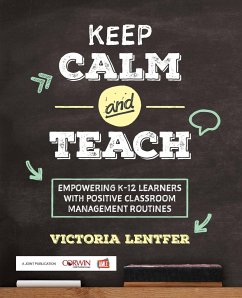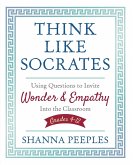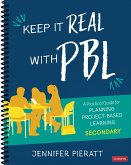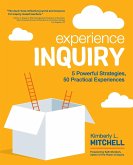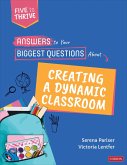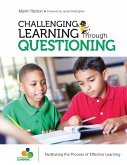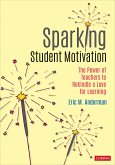Victoria S. Lentfer
Keep CALM and Teach
Empowering K-12 Learners With Positive Classroom Management Routines
Victoria S. Lentfer
Keep CALM and Teach
Empowering K-12 Learners With Positive Classroom Management Routines
- Broschiertes Buch
- Merkliste
- Auf die Merkliste
- Bewerten Bewerten
- Teilen
- Produkt teilen
- Produkterinnerung
- Produkterinnerung
CALM stands for Communication, Accountability, Leadership, and Motivation - an actionable, clear, and easy to remember framework for redirecting student behavior in the classroom.
Andere Kunden interessierten sich auch für
![Think Like Socrates Think Like Socrates]() Shanna PeeplesThink Like Socrates44,99 €
Shanna PeeplesThink Like Socrates44,99 €![Keep It Real With PBL, Secondary Keep It Real With PBL, Secondary]() Jennifer R. PierattKeep It Real With PBL, Secondary47,99 €
Jennifer R. PierattKeep It Real With PBL, Secondary47,99 €![Experience Inquiry Experience Inquiry]() Kimberly L. MitchellExperience Inquiry44,99 €
Kimberly L. MitchellExperience Inquiry44,99 €![Answers to Your Biggest Questions About Creating a Dynamic Classroom Answers to Your Biggest Questions About Creating a Dynamic Classroom]() Serena PariserAnswers to Your Biggest Questions About Creating a Dynamic Classroom41,99 €
Serena PariserAnswers to Your Biggest Questions About Creating a Dynamic Classroom41,99 €![Challenging Learning Through Questioning Challenging Learning Through Questioning]() Martin RentonChallenging Learning Through Questioning41,99 €
Martin RentonChallenging Learning Through Questioning41,99 €![Sparking Student Motivation Sparking Student Motivation]() Eric M. Anderman (USA The Ohio State University)Sparking Student Motivation48,99 €
Eric M. Anderman (USA The Ohio State University)Sparking Student Motivation48,99 €![How to Personalize Learning How to Personalize Learning]() Barbara A. BrayHow to Personalize Learning42,99 €
Barbara A. BrayHow to Personalize Learning42,99 €-
-
-
CALM stands for Communication, Accountability, Leadership, and Motivation - an actionable, clear, and easy to remember framework for redirecting student behavior in the classroom.
Hinweis: Dieser Artikel kann nur an eine deutsche Lieferadresse ausgeliefert werden.
Hinweis: Dieser Artikel kann nur an eine deutsche Lieferadresse ausgeliefert werden.
Produktdetails
- Produktdetails
- Corwin Teaching Essentials
- Verlag: SAGE Publications Inc
- Seitenzahl: 242
- Erscheinungstermin: 21. September 2018
- Englisch
- Abmessung: 235mm x 191mm x 13mm
- Gewicht: 492g
- ISBN-13: 9781506397764
- ISBN-10: 150639776X
- Artikelnr.: 52417628
- Herstellerkennzeichnung
- Libri GmbH
- Europaallee 1
- 36244 Bad Hersfeld
- gpsr@libri.de
- Corwin Teaching Essentials
- Verlag: SAGE Publications Inc
- Seitenzahl: 242
- Erscheinungstermin: 21. September 2018
- Englisch
- Abmessung: 235mm x 191mm x 13mm
- Gewicht: 492g
- ISBN-13: 9781506397764
- ISBN-10: 150639776X
- Artikelnr.: 52417628
- Herstellerkennzeichnung
- Libri GmbH
- Europaallee 1
- 36244 Bad Hersfeld
- gpsr@libri.de
Dr. Victoria Lentfer is an education instructor at the University of Nebraska at Omaha. She teaches classroom management and middle level courses. She is an educational consultant and founder of the CALM Classroom Management Program, which is a comprehensive behavior management and teacher leader program that provides communication models to guide teachers and students to an inclusive and productive classroom. She has more than 20 years of experience of providing instructional support and teaching at both the middle and high school urban districts, and extensive work with incarcerated youth. Victoria has also been a Trailblazer Leader and keynote speaker for the Association of Middle Level Education (AMLE).
Preface
Acknowledgments
About the Author
Chapter 1: The CALM Management Program
How I Got From There to Here
Teach Content and Behavior
CALM Management
Communication
Accountability
Leadership
Motivation
Proactive Measures
Positive Reinforcements
Pacing
Learning Goals
Behavior Goals
Summary
Reflection Questions
Quick Wins
Part I: CALM Communication
Chapter 2: Positive Behavior Expectations
Explicit Expectations Lead to Positive Results
In the Research
Beginning the CALM Classroom Process
Bullying
Special Situations
Summary
Reflection Questions
Quick Wins
Chapter 3: Redirect Behavior Model
Redirect Behavior Model Defined
Empower Students
Framework of the Redirect Behavior Model
Implementing the Phases of the Redirect Behavior Model
Phase I: Explain Student Behavior Expectations
Phase I: Noncompliance-What to Do if a Student Does Not Accept the
Redirection
Phase II: Encourage Student Ownership
Phase III: Problem-Solve With the Noncompliant Student
Delivering the Redirect Behavior Model
Say It and Move On
Make It Conversational
Be Prepared for Students to Feel Uncomfortable
Remain Calm
Redirect Behavior Model for Instruction
Summary
Reflection Questions
Quick Wins
Chapter 4: Voice-Movement-Task Model
Voice-Movement-Task Model Defined
Research
When to Use
Voice
Movement
Materials
Task
Summary
Reflection Questions
Quick Wins
Part II: CALM Accountability
Chapter 5: Accountability-Collaborative Work Groups
Think Beyond the Four Walls . . .
Small-Group Interaction Model
Prior to Activity (Standard Procedures for All Activities)
Peer Feedback
How to Teach Students to Provide Academic Feedback
Positive Behavior Expectations for Feedback
Role-Play Scenarios
Summary
Reflection Questions
Quick Wins
Chapter 6: Accountability-Conversations, Consequences, and Follow Through
Student Choices
Consequences to Promote Growth
Conversations to Promote Growth
Relying on Positive Consequences May Require a Change in Mindset
Positive Consequences
Consequences That Address Negative Behavior
Inappropriate Responses to Negative Behavior
Consequence Progression
Follow Through
Summary
Reflection Questions
Quick Wins
Part III: CALM Leadership
Chapter 7: Teacher as a Leader
Five Effective Practices for a Teacher Leader
Reflective Practice
Communication
Teacher Presence
Positive Mindset
Instruction
Summary
Reflection Questions
Quick Wins
Chapter 8: Student as a Leader
The Student Communication Model
Community Council
Purpose of the Community Council
Appointing the Council Leader
When the Council Convenes
Community Council Whole-Class Meeting Protocol
Teacher Role
Incentive
Summary
Reflection Questions
Quick Wins
Part IV: CALM Motivation
Chapter 9: Motivation Plan
Motivation Plan-Whole Class
Disengaged Student-Work for Wins
Disengaged Student-Mentor Tutoring
Summary
Reflection Questions
Quick Wins
Chapter 10: Final Thoughts
Key Takeaways
One Last Collaborative Group Activity
Where Do We Go From Here?
References
Index
Acknowledgments
About the Author
Chapter 1: The CALM Management Program
How I Got From There to Here
Teach Content and Behavior
CALM Management
Communication
Accountability
Leadership
Motivation
Proactive Measures
Positive Reinforcements
Pacing
Learning Goals
Behavior Goals
Summary
Reflection Questions
Quick Wins
Part I: CALM Communication
Chapter 2: Positive Behavior Expectations
Explicit Expectations Lead to Positive Results
In the Research
Beginning the CALM Classroom Process
Bullying
Special Situations
Summary
Reflection Questions
Quick Wins
Chapter 3: Redirect Behavior Model
Redirect Behavior Model Defined
Empower Students
Framework of the Redirect Behavior Model
Implementing the Phases of the Redirect Behavior Model
Phase I: Explain Student Behavior Expectations
Phase I: Noncompliance-What to Do if a Student Does Not Accept the
Redirection
Phase II: Encourage Student Ownership
Phase III: Problem-Solve With the Noncompliant Student
Delivering the Redirect Behavior Model
Say It and Move On
Make It Conversational
Be Prepared for Students to Feel Uncomfortable
Remain Calm
Redirect Behavior Model for Instruction
Summary
Reflection Questions
Quick Wins
Chapter 4: Voice-Movement-Task Model
Voice-Movement-Task Model Defined
Research
When to Use
Voice
Movement
Materials
Task
Summary
Reflection Questions
Quick Wins
Part II: CALM Accountability
Chapter 5: Accountability-Collaborative Work Groups
Think Beyond the Four Walls . . .
Small-Group Interaction Model
Prior to Activity (Standard Procedures for All Activities)
Peer Feedback
How to Teach Students to Provide Academic Feedback
Positive Behavior Expectations for Feedback
Role-Play Scenarios
Summary
Reflection Questions
Quick Wins
Chapter 6: Accountability-Conversations, Consequences, and Follow Through
Student Choices
Consequences to Promote Growth
Conversations to Promote Growth
Relying on Positive Consequences May Require a Change in Mindset
Positive Consequences
Consequences That Address Negative Behavior
Inappropriate Responses to Negative Behavior
Consequence Progression
Follow Through
Summary
Reflection Questions
Quick Wins
Part III: CALM Leadership
Chapter 7: Teacher as a Leader
Five Effective Practices for a Teacher Leader
Reflective Practice
Communication
Teacher Presence
Positive Mindset
Instruction
Summary
Reflection Questions
Quick Wins
Chapter 8: Student as a Leader
The Student Communication Model
Community Council
Purpose of the Community Council
Appointing the Council Leader
When the Council Convenes
Community Council Whole-Class Meeting Protocol
Teacher Role
Incentive
Summary
Reflection Questions
Quick Wins
Part IV: CALM Motivation
Chapter 9: Motivation Plan
Motivation Plan-Whole Class
Disengaged Student-Work for Wins
Disengaged Student-Mentor Tutoring
Summary
Reflection Questions
Quick Wins
Chapter 10: Final Thoughts
Key Takeaways
One Last Collaborative Group Activity
Where Do We Go From Here?
References
Index
Preface
Acknowledgments
About the Author
Chapter 1: The CALM Management Program
How I Got From There to Here
Teach Content and Behavior
CALM Management
Communication
Accountability
Leadership
Motivation
Proactive Measures
Positive Reinforcements
Pacing
Learning Goals
Behavior Goals
Summary
Reflection Questions
Quick Wins
Part I: CALM Communication
Chapter 2: Positive Behavior Expectations
Explicit Expectations Lead to Positive Results
In the Research
Beginning the CALM Classroom Process
Bullying
Special Situations
Summary
Reflection Questions
Quick Wins
Chapter 3: Redirect Behavior Model
Redirect Behavior Model Defined
Empower Students
Framework of the Redirect Behavior Model
Implementing the Phases of the Redirect Behavior Model
Phase I: Explain Student Behavior Expectations
Phase I: Noncompliance-What to Do if a Student Does Not Accept the
Redirection
Phase II: Encourage Student Ownership
Phase III: Problem-Solve With the Noncompliant Student
Delivering the Redirect Behavior Model
Say It and Move On
Make It Conversational
Be Prepared for Students to Feel Uncomfortable
Remain Calm
Redirect Behavior Model for Instruction
Summary
Reflection Questions
Quick Wins
Chapter 4: Voice-Movement-Task Model
Voice-Movement-Task Model Defined
Research
When to Use
Voice
Movement
Materials
Task
Summary
Reflection Questions
Quick Wins
Part II: CALM Accountability
Chapter 5: Accountability-Collaborative Work Groups
Think Beyond the Four Walls . . .
Small-Group Interaction Model
Prior to Activity (Standard Procedures for All Activities)
Peer Feedback
How to Teach Students to Provide Academic Feedback
Positive Behavior Expectations for Feedback
Role-Play Scenarios
Summary
Reflection Questions
Quick Wins
Chapter 6: Accountability-Conversations, Consequences, and Follow Through
Student Choices
Consequences to Promote Growth
Conversations to Promote Growth
Relying on Positive Consequences May Require a Change in Mindset
Positive Consequences
Consequences That Address Negative Behavior
Inappropriate Responses to Negative Behavior
Consequence Progression
Follow Through
Summary
Reflection Questions
Quick Wins
Part III: CALM Leadership
Chapter 7: Teacher as a Leader
Five Effective Practices for a Teacher Leader
Reflective Practice
Communication
Teacher Presence
Positive Mindset
Instruction
Summary
Reflection Questions
Quick Wins
Chapter 8: Student as a Leader
The Student Communication Model
Community Council
Purpose of the Community Council
Appointing the Council Leader
When the Council Convenes
Community Council Whole-Class Meeting Protocol
Teacher Role
Incentive
Summary
Reflection Questions
Quick Wins
Part IV: CALM Motivation
Chapter 9: Motivation Plan
Motivation Plan-Whole Class
Disengaged Student-Work for Wins
Disengaged Student-Mentor Tutoring
Summary
Reflection Questions
Quick Wins
Chapter 10: Final Thoughts
Key Takeaways
One Last Collaborative Group Activity
Where Do We Go From Here?
References
Index
Acknowledgments
About the Author
Chapter 1: The CALM Management Program
How I Got From There to Here
Teach Content and Behavior
CALM Management
Communication
Accountability
Leadership
Motivation
Proactive Measures
Positive Reinforcements
Pacing
Learning Goals
Behavior Goals
Summary
Reflection Questions
Quick Wins
Part I: CALM Communication
Chapter 2: Positive Behavior Expectations
Explicit Expectations Lead to Positive Results
In the Research
Beginning the CALM Classroom Process
Bullying
Special Situations
Summary
Reflection Questions
Quick Wins
Chapter 3: Redirect Behavior Model
Redirect Behavior Model Defined
Empower Students
Framework of the Redirect Behavior Model
Implementing the Phases of the Redirect Behavior Model
Phase I: Explain Student Behavior Expectations
Phase I: Noncompliance-What to Do if a Student Does Not Accept the
Redirection
Phase II: Encourage Student Ownership
Phase III: Problem-Solve With the Noncompliant Student
Delivering the Redirect Behavior Model
Say It and Move On
Make It Conversational
Be Prepared for Students to Feel Uncomfortable
Remain Calm
Redirect Behavior Model for Instruction
Summary
Reflection Questions
Quick Wins
Chapter 4: Voice-Movement-Task Model
Voice-Movement-Task Model Defined
Research
When to Use
Voice
Movement
Materials
Task
Summary
Reflection Questions
Quick Wins
Part II: CALM Accountability
Chapter 5: Accountability-Collaborative Work Groups
Think Beyond the Four Walls . . .
Small-Group Interaction Model
Prior to Activity (Standard Procedures for All Activities)
Peer Feedback
How to Teach Students to Provide Academic Feedback
Positive Behavior Expectations for Feedback
Role-Play Scenarios
Summary
Reflection Questions
Quick Wins
Chapter 6: Accountability-Conversations, Consequences, and Follow Through
Student Choices
Consequences to Promote Growth
Conversations to Promote Growth
Relying on Positive Consequences May Require a Change in Mindset
Positive Consequences
Consequences That Address Negative Behavior
Inappropriate Responses to Negative Behavior
Consequence Progression
Follow Through
Summary
Reflection Questions
Quick Wins
Part III: CALM Leadership
Chapter 7: Teacher as a Leader
Five Effective Practices for a Teacher Leader
Reflective Practice
Communication
Teacher Presence
Positive Mindset
Instruction
Summary
Reflection Questions
Quick Wins
Chapter 8: Student as a Leader
The Student Communication Model
Community Council
Purpose of the Community Council
Appointing the Council Leader
When the Council Convenes
Community Council Whole-Class Meeting Protocol
Teacher Role
Incentive
Summary
Reflection Questions
Quick Wins
Part IV: CALM Motivation
Chapter 9: Motivation Plan
Motivation Plan-Whole Class
Disengaged Student-Work for Wins
Disengaged Student-Mentor Tutoring
Summary
Reflection Questions
Quick Wins
Chapter 10: Final Thoughts
Key Takeaways
One Last Collaborative Group Activity
Where Do We Go From Here?
References
Index

